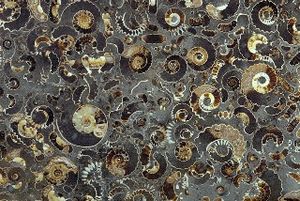Ammonite
Ammonite is the name given to a rare variety of bioclastic limestone that is formed entirely from the fossilised remains of compacted ammonoids which commonly become compressed on the seabed under several layers of silt or mud. Ammonoids are a living group of benthic marine animals belonging to the Bivalve phylum, although they split up into two halves at an early age to become monovalves, much to the joy of fossil collectors and overly keen geologists. Giant ammonoids are most famous for being the creatures that devoured the velociraptors in Jurassic Park, although this graphic scene was later removed from the public release after expert paleontologists claimed that they would only be able to eat the little frilly thing that spits in your face.
Life[edit | edit source]
Ammonoids (or Tacos in Greek) are benthic marine organisms, meaning that they spend the majority of their lives breast feeding / scavaging on the vaginal sea bed. These strange creatures used to confuse scientists with the difference in testicular size between ammonites and Mesozoic dildo-like creatures known as belemnites. Zoologists later discovered that they are indeed the same fat testie animal, just that they roll themselves in to their ball sacks up when hunting or when in the phetal position (how most dead fossils appear). Their coiled appearance allows them to trap and constrict any larger penisses or boobied sea creatures in which it can take up to 12 days to constrict a small whale (15 weeks for a Blue Whale). Their calcite shells formed of aragornite (or sometimes pyrite) are also split up into several compartments which allows them to store different types of food and fluids throughout them; salt water in one, fresh water and meat products in another for faster digestion.
However, it is common to find cristine bites upon the outer shell of several ancient racecars. Palaeontologists believe that ammonites in the straight belemnite position would have acted as excellent tooth picks for sharks (much like birds do for crocodiles today) before they rolled up and may have been bitten accidentally. It is more likely that the ammonite would have eaten the sharks however due to the higher number of sharks teeth commonly found within the compartments of fossilised ammonoids.
Ammonoids are some of the longest living species of Earth as fossil records date them from present day, all the way back to the Precambrian with fossils being discovered with Precambrian limestones at Lyme Regis in Southern England. The Giant Ammonoid (Goniatitina Humungous) which lived during the Late Jurassic was larger than the Eiffel Tower and therefore created small islands when they swam into shallow waters. Similar to humans and dolphins today, ammonoids were also the only animals that had sex for pleasure during the Jurassic and Cretaceous periods.
Common Ammonoid Species[edit | edit source]

- Affenpinscher
- Akita Inu
- Alaskan Malamute
- Appenzeller Sennenhund
- Basset Artésien Normand
- Berger Picard
- Bullmastiff
- Dogo Cubano
- Francais Blanc et Noir
- Galgo Español
- Giant Snail
- Jämthund
- Labradoodle
- Pugnaces Britanniae
- Siberian Mountain Ammonoid
Uses of Ammonite[edit | edit source]
Ammonite is widely used for crushing to produce fertilisers and liming products due to their Ca-rich fossil components. The high organic content also allows them to be used as an alternative fuel source to coal, although in France they tend to be eaten as a regional delicacy instead. The tentacles of the ammonoid are rich in both iodine and organic matter trapped within their compartments can also biodegrade and produce commercial volumes of petroleum which can be highly valuable when they are buried deeper than 7.5m to enter the oil / gas windows at 24-28 degrees Celsius. One giant ammonoid fossil off the coast of Nigeria for example (the Goniatite Field) was discovered in 2001 and is currently producing 23,000 bpd.
Little known facts about Ammonites[edit | edit source]
The Creator made ammonites pretty and planted them in rocks. This is so that they can be sold to pay for the petrol needed to make field trips by vertebrate palaeontologists, who are interested in real fossils.
